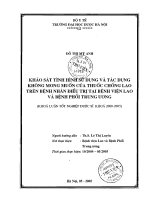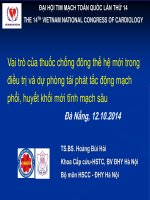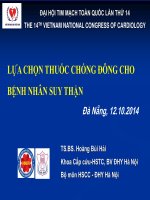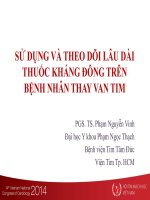Vai Trò Của Thuốc Chống Đông Trên Bệnh Nhân Rung Nhĩ Mới Xuất Hiện
Bạn đang xem bản rút gọn của tài liệu. Xem và tải ngay bản đầy đủ của tài liệu tại đây (1.69 MB, 21 trang )
VAI TRÕ CỦA THUỐC CHỐNG ĐÔNG
TRÊN BỆNH NHÂN RUNG NHĨ MỚI
XUẤT HIỆN
Bs. Phạm Trần Linh
Viện Tim mạch
ĐIỀU TRỊ RUNG NHĨ
Mục tiêu:
Kiểm soát tần số thất
Chuyển nhịp và duy trì nhịp xoang
Phòng ngừa huyết khối thuyên tắc
Patient with diagnosis of atrial fibrillation
Hemodynamically
stable
Yes
Control ventricular rate:
Diltiazem
•Beta Blockers
•Calcium Channel blockers
•Digoxin
•Amiodarone
Long standing HTN
No
Unstable…
•Hypotension
•Confusion
Cardioversion
•Angina
•….
Ischemic heart dz
Spontaneous conversion to sinusCHF
rhythm
Hyperthyroidism
PE
Yes
No
Lung ca
Alcohol
Assess cause of
Hypothermia
Contraindication to cardioversion?
atrial fibrillation
Electrolytes imbalance
Etc. .
Cont’
Cont’
Yes
No
Cardiversion
Start Heparin IV
Warfarin
Consider
long-term
anticoagulation
NOAC
Yes
Aspirin
<48hs
•Immediate
medical or
electrical
Long standing HTN
cardioversion
Ischemic heart dz
CHF
Hyperthyroidism
Atrial fibrillation persist?
PE
Lung ca
No
Alcohol
Hypothermia
Assess cause of atrial
Electrolytes imbalance
fibrillation
Etc. .
>48hs
•Later elective
cardioversion
after 3weeks of
warfarin
• Early TEEguided
cardioversion
UCLA Family Medicine Department IMG Program
Nguy cơ đột quỵ/RN dựa theo chỉ số
CHA2DS2-VASc
CHA2DS2-VASc
criteria
Score
Congestive heart failure/
left ventricular dysfunction
1
Hypertension
1
Age 75 yrs
2
Diabetes mellitus
1
Stroke/transient ischaemic attack/TE
2
Vascular disease
(prior myocardial infarction, peripheral
artery disease or aortic plaque)
1
Age 65–74 yrs
1
Sex category (i.e. female gender)
1
CHA2DS2-VASc
total score
Rate of stroke/other TE
(%/yr) (95% CI)*
0
0 (0–0)
1
0.6 (0.0–3.4)
2
1.6 (0.3–4.7)
3
3.9 (1.7–7.6)
4
1.9 (0.5–4.9)
5
3.2 (0.7–9.0)
6
3.6 (0.4–12.3)
7
8.0 (1.0–26.0)
8
11.1 (0.3–48.3)
9
100 (2.5–100)
Thang điểm đánh giá nguy cơ chảy máu
HAS- BLED
Chữ
Đặc điểm lâm sàng
Điểm số
H
Hypertension (Huyết áp cao)
1
A
Abnormal renal and liver function (Bất thường chức năng gan
và thận, mỗi cái 1 điểm)
S
Stroke (Đột quỵ)
1
B
Bleeding (Chảy máu)
1
L
Labile INR (Dao động INR)
1
E
Elderly (Cao tuổi, tuổi > 65)
1
D
Thuốc/rượu (Mỗi cái 1 điểm)
1 hoặc 2
1 hoặc 2
Tối đa 9 điểm
HAs- BLED ≥ 3: nguy cơ chảy máu cao
Huyết áp cao: khi huyết áp tâm thu > 160 mmHg
Bất thường chức năng thận: khi bệnh nhân đang chạy thận nhân tạo định kỳ, ghép thận, hoặc creatinine máu ≥ 200 µmol/L
Bất thường chức năng gan: khi có bệnh gan mạn (vd: xơ gan), hoặc có bằng chứng sinh hoá của xáo trộn chức năng gan nặng (vd: bilirubin >
2 lần giới hạn trên bình thường, hoặc AST/ALT/Phosphatase kiềm > 3 lần giới hạn trên bình thường)
Chảy máu: khi bệnh nhân có tiền sử chảy máu, và/ hoặc có yếu tố thúc đẩy chảy máu (vd: chảy máu nội tạng, thiếu máu…)
INR dao động: khi INR cao hoặc không ổn định, hoặc thời gian trong khoảng điều trị thấp (TTR, Time in Therapeutic Range, thời gian INR
đạt trong ngưỡng điều trị < 60%)
Thuốc/Rượu: các thuốc điều trị đi kèm như thuốc chống kết tập tiểu cầu, kháng viêm non-steroides, hoặc nghiện rượu,…
Lựa chọn kháng đông
Atrial fibrillation
Yes
Valvular AF*
No (i.e. nonvalvular)
Yes
<65 years and lone AF (including females)
No
Assess risk of stroke
CHA2DS2-VASc score
0
1
≥2
Oral anticoagulant therapy
Assess bleeding risk
(HAS-BLED score)
Consider patient values and preferences
No antithrombotic
therapy
NOAC
VKA
Một số hạn chế của kháng vit K so với
Dabigatran
Hiệu quả phòng ngừa đột quỵ của NOAC
so với Warfarin
No of events (%/yr)
Dabi 110
NOAC
Warfarin
HR
95% CI
171 (1.44)
186 (1.58)
0.91
0.74–1.12
122 (1.01)
186 (1.58)
0.64
0.51–0.81
184 (1.65)
221 (1.96)
0.85
0.70–1.03
199 (1.19)
250 (1.51)
0.79
0.65–0.95
(ITT)
Dabi 150
(ITT)
Riva
(Safety AT)
Apixaban
(ITT)
0.0
0.5
Not head-to-head comparison – for illustrative purposes only – adapted from references 1–4
AT = as treated; Dabi 110/150 = dabigatran 110 mg/150 mg twice daily; HR = hazard ratio;
Favours
ITT = intention-to-treat; NOAC = new oral anticoagulant; riva = rivaroxaban
1. Connolly SJ et al. N Engl J Med 2009;361:1139–51; 2. Connolly SJ et al. N Engl J Med
2010;363:1875–6;
3. Patel MR et al. N Engl J Med 2011;365:883–91; 4. Granger C et al. N Engl J Med 2011;365:981–92
1.0
NOAC
1.5
Favours warfarin
NOAC: kháng đông mới
2.0
TRƢỜNG HỢP LÂM SÀNG
BN Nam, 40 tuổi.
Buổi tối trước khi nhập viện có uống khoảng 200ml rượu
Whiskey, sau đó mất ngủ trong cả đêm.
5h00 thức dậy thấy hồi hộp đánh trống ngực.
Đau đầu, mệt nhiều.
Tiền sử: khỏe mạnh, chưa phát hiện THA, tiểu đường, đột quỵ,
chưa bị hồi hộp đánh trống ngực bao giờ.
Khám lâm sàng: không đau ngực, khó thở nhẹ, vã mồ hôi.
Tim 140ck/p, nhịp không đều, phổi không rales,
HA 135/80mmHg.
ĐIỆN TÂM ĐỒ
Overview of AF Management
AF Detected
Management of
Arrhythmia
Assessment of
Thromboembolic
Risk (CHADS2)
ASA
OAC
Rate
Control
No antithrombotic therapy may be appropriate in selected
young patients with no stroke risk factors
Rhythm
Control
Kiểm soát nhịp cho bệnh nhân
1. Sốc điện (150 – 200J): càng sớm càng tốt.
2. Digoxin 0,25mg TM, 1h nhắc lại x 4 lần nếu còn rung nhĩ.
3. Amiodarone tĩnh mạch 150mg trong 10 phút, sau đó
1mg/phút trong 6h 0,5mg/phút trong 18h hoặc chuyển
sang đường uống 400mg/ngày.
4. Metoprolol 50mg / ngày.
5. Amiodarone tĩnh mạch trong 6h nếu vẫn còn rung nhĩ
tần số dưới 110ck/p sốc điện.
BN nam không có nguy cơ đột quỵ. Rung nhĩ
mới xuất hiện < 24h liên quan đến uống rƣợu
chuyển nhịp xoang là lựa chọn tối ƣu cho
bệnh nhân.
Có cần thiết giảm nguy cơ đột quỵ
cho bn khi chuyển nhịp không?
1. TM LMWH hoặc NOAC trước 1h khi chuyển nhịp
bằng thuốc hoặc sốc điện.
2. TM LMWH hoặc NOAC 1 giờ trước khi sốc điện
chuyển nhịp, không cần khi chuyển nhịp bằng
thuốc.
3. Không cần dùng thuốc chống đông trước khi
chuyển nhịp.
4. Uống NOAC trong 3 tuần sau khi chuyển nhịp
thành công.
Management of AF in the ED – Recommendations
Is Patient Stable?
Immediate Risk for
Stroke?
Low Risk
1. Clear onset <48 hours, or
2. Therapeutic OAC ≥ 3 wks
Pharmacological or
electrical CV at 150-200 J
(Immediate anticoagulation in ED
before CV not required) *
Antithrombotic therapy
-Initiate OAC upon discharge from ED (or
continue current OAC) if age ≥ 65 or
CHADS2 ≥ 1
-Otherwise, initiate ASA if CAD or vascular
disease
-Early follow-up to review long-term OAC
YES
NO
High Risk**
No therapeutic OAC ≥ 3 weeks and one of:
1. Onset >48 hours or unknown, or
2. Stroke/TIA <6 months or
3. Mechanical or rheumatic valve disease.
Rate-control
Therapeutic OAC for 3
Trans-esophageal
weeks before
echocardiography (TEE)
outpatient CV
guided CV
Antithrombotic therapy
- Continue OAC for ≥4
weeks after CV
- Early follow-up to review
long-term OAC
Antithrombotic therapy
- Initiate immediate OAC* in ED
and continue for ≥4 weeks
- Early follow-up to review
long-term OAC
Unstable – AF causing:
1. Hypotension, or
2. Cardiac ischemia, or
3. Pulmonary edema
Consider urgent
electrical CV if rate
control not effective
Antithrombotic therapy
- Initiate immediate OAC* in ED and
continue for ≥4 weeks if any ‘high
risk’ ** features present
Early follow-up to review
long-term OAC
* Immediate OAC = a dose of OAC should be given just prior to cardioversion - either a novel direct oral anticoagulant (NOAC) or a dose of heparin or low molecular weight heparin
with bridging to warfarin if a NOAC is contraindicated.
CÓ CẦN THIẾT GIẢM NGUY CƠ ĐỘT QUỴ CHO
BN KHI RA VIỆN?
1. Nếu vẫn còn rung nhĩ Aspirin 100mg/ngày.
2. Nếu chuyển về nhịp xoang thành công Aspirin
100mg/ngày x 1 tháng.
3. Nếu còn rung nhĩ OAC ít nhất 1 tháng.
4. Nếu chuyển về nhịp xoang OAC ít nhất 1 tháng.
5. Không cần điều trị chống đông trong trường hợp
chuyển được về nhịp xoang hoặc vẫn còn rung
nhĩ.
The “ACC Algorithm” for OAC Therapy in AF
Age 65
OAC*
YES
NO
Prior Stroke/SE/TIA or
Hypertension
or
Heart failure
or
Diabetes Mellitus
OAC*
YES
(CHADS2 risk factors)
**may require lower dosing
NO
CAD or
Arterial vascular disease
Consider and modify (if possible)
all factors influencing risk of
bleeding on OAC (hypertension,
antiplatelet drugs, NSAIDs,
excessive alcohol, labile INRs)
and specifically bleeding risks for
NOACs (low eGFR, age ≥ 75, low
body weight)**
YES
ASA
(coronary, aortic, peripheral)
NO
No
Antithrombotic
* We suggest that a NOAC be used in preference
to warfarin for non-valvular AF.
Recommendation
For patients at high risk of stroke with cardioversion (not
receiving therapeutic OAC therapy for 3 weeks with any of
the following: AF episode duration not clearly < 48 hours,
stroke or TIA within 6 months, rheumatic heart disease,
mechanical valve), we recommend optimized rate control
and therapeutic OAC for 3 weeks before and at least 4
weeks after cardioversion.
(Strong Recommendation, Moderate-Quality Evidence)
Recommendation
We suggest that patients at high risk of stroke (not
receiving therapeutic OAC therapy for 3 weeks with any of
the following: AF episode duration not clearly < 48 hours,
stroke or TIA within 6 months, rheumatic heart disease,
mechanical valve) may undergo cardioversion guided by
transesophageal echocardiography with immediate
initiation of intravenous heparin or low molecular weight
heparin (LMWH) before cardioversion followed by
therapeutic OAC for at least 4 weeks after cardioversion.
(Conditional Recommendation, Moderate-Quality Evidence)
Recommendation
For patients whose recent-onset AF/AFL is the direct
cause of instability with hypotension, acute coronary
syndrome, or florid pulmonary edema, we recommend that
immediate electrical cardioversion be considered with
immediate initiation of intravenous or LMWH before
cardioversion followed by therapeutic OAC for 4 weeks
afterward (unless AF onset was clearly within 48 hours or
the patient has received therapeutic OAC for 3 weeks)
followed by therapeutic OAC for at least 4 weeks after
cardioversion
(Strong Recommendation, Low-Quality Evidence)
XIN CẢM ƠN









